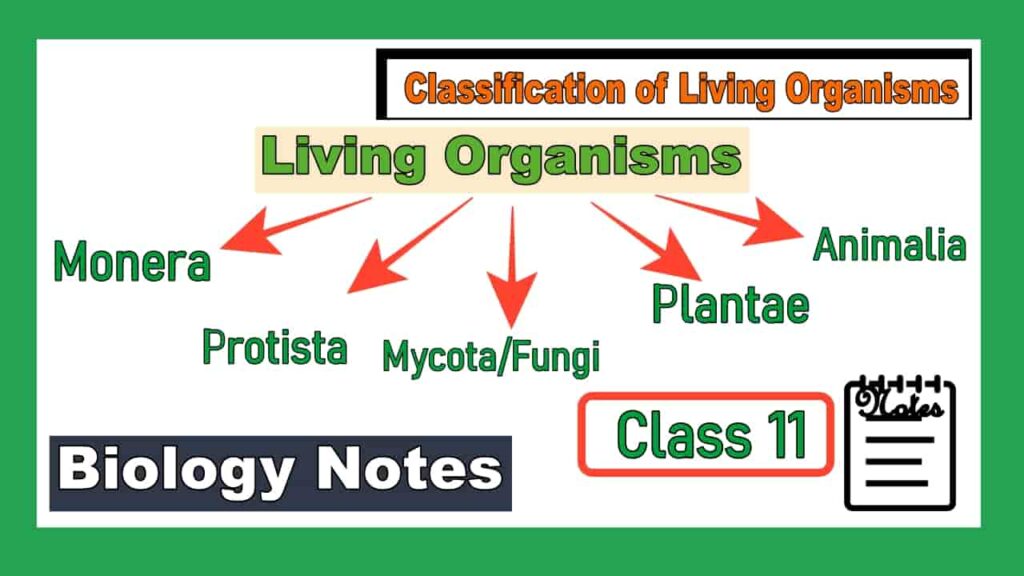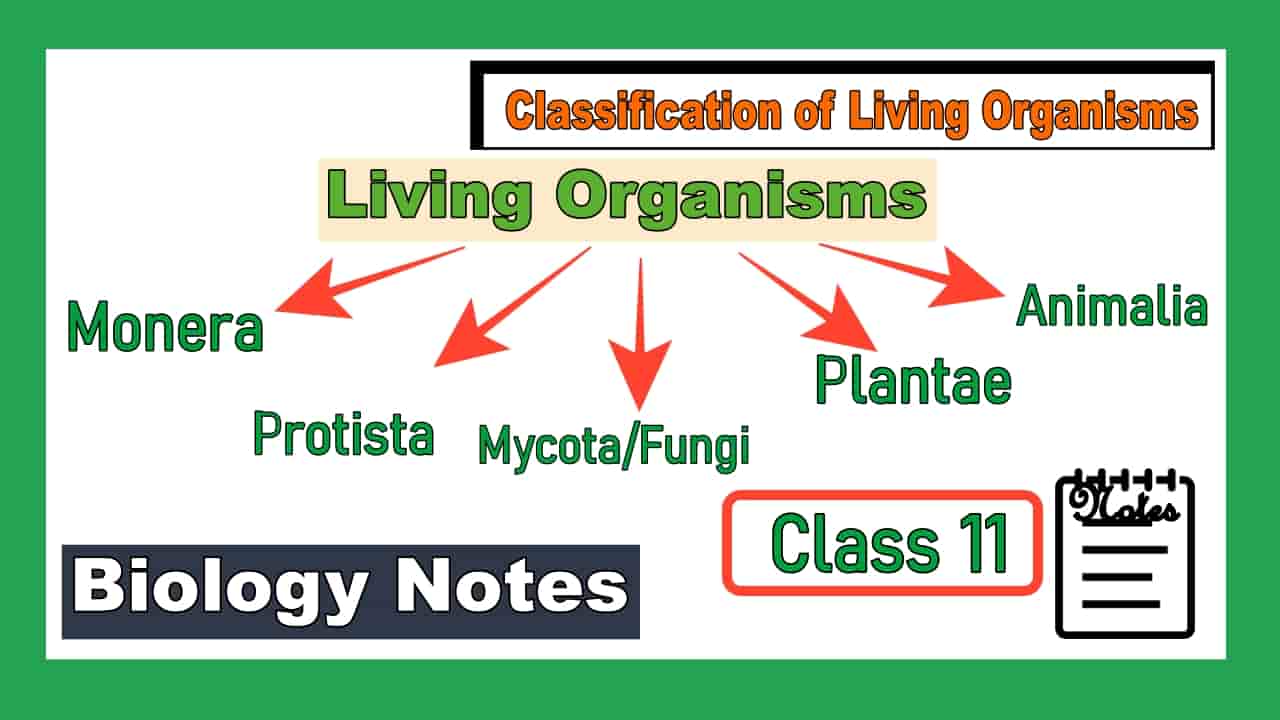Classification of Living Organisms
Since the dawn of civilization, several attempts have been made to classify organisms. It was created naturally without the use of scientific standards, but removed from the need to use organisms for our own use in food, shelter, and clothing. Aristotle first laid the scientific basis for the Classification of Living Organisms. They used simple morphological workers to classify plants into trees, shrubs, and plants. They divided the animals into two groups, those with red blood and those without.

In Classification of Living Organisms, Classification refers to events occurring in groups based on the origin, evolution, morphology, anatomy, and cytology of organisms. With this method, the exact position of an organism in the living world can be learned accurately. various systems of classification have been developed Over the years.
TWO KINGDOM SYSTEM
Different groups of organisms have been divided into two main groups called plants and animals since ancient times. The Greek philosopher Aristotle (384–322 BCE) and his disciple Theophrastus underlined the importance of classifying living things.
In Classification of Living Organisms we classify plants and animals into subgroups based on some similarities and differences among them.
Carolus Linnaeus (1707–1778), also known as the father of modern botany and the father of taxonomy, divided all living things into two states, such as plants and animals, based on certain structural and functional personnel. is.
For example, plant cells have a cell wall outside the plasma membrane. In general, plants have the ability to integrate their own organic foods. All tall plants are large, stable and unable to move from one place to another. In addition, plants are less responsive to external changes in their environments.
In the animal kingdom, there is no inanimate organ called cell wall. They do not integrate their own food, so they directly or indirectly depend on plants for food. The animals are therefore heterotrophic.
Animals move freely for various purposes, such as food and shelter. Animals react immediately to stimuli or any change in the environment in Classification of Living Organisms.
Plants separated from animals are given in the table
Also read Taxonomy hierarchy And Systematics Class 11 Notes Biology Chapter 1
Characteristics of two kindom Classification
[table id=4 / responsive=scroll ]
Merits/Demerits of Two Kingdom system of classification
Merits
1) Plants and animals are not suddenly divided into two states based on specific personnel.
2) It introduced a systematic way of classifying organisms. More and more employees are considering coming up with better methods in the end.
Demerits
1) This classification system does not deal with the condition of microorganisms in the living world – for example, viruses and bacteria. The reason is that the creatures were not well known at that time.
2) In some creatures such as slim molts and euclina some characters are similar to plants and animals. Small plants with thin molds and no cell walls, eucalypts are minute animals with green pigmented structures. Therefore, their status in the living world is uncertain.
3) The status of prokaryotes is completely ignored.
Also read our popular article Difference Between Living And Nonliving Organisms Biology Notes
FIVE KINGDOM SYSTEM OF CLASSIFICATION
For Classification of Living Organisms American taxonomist Robert H. Whitaker proposed five states in 1969 for the classification of organisms. The classification system is based on three criteria.
(A) Cellular system: Cells can be prokaryotic or eukaryotic
(B) Body structure: Biodiversity organisms with a single and simple structure in the complex body;
(C) Nutrition: autotrophic to heterotrophic and absorbent. The global role of organisms is also considered in the global taxonomy of organisms.
The Classification of Living Organisms classified the species into five states: Monera, Protista, Mycota, plante, and Animalia.
Kingdom Monera
Example – Bacteria, Cyanobacteria (Blue-green algae)
- Unicellular organisms without nuclei and nuclear membranes are composed of this state. Furthermore, not all membrane-binding organs such as mitochondria, chloroplasts, lysosomes are present in the monora cell. Plasma is present in photosynthetic organisms due to the development of the plasma membrane.
- The only cytoplasmic organelle ribosome occurring in these organisms in classification of living organism.
- Classification of Living Organisms peptidoglycan is the major component of the cell wall.
- The flag has a formula-like structure. Its main component is flagellin without a 2 + 9 structure.
- Organisms under this group show nutritional diversity. It can be autotrophic or heterotrophic. There are many heterotrophic that can cause decay and degradation.
- Sexual reproduction in these organisms is very less. Most organisms breed vegetatively or abnormally. Sometimes genetic recombination may occur.
- A cell has only one chromosome. Here the DNA component is round without the original chromosome protein.
Kingdom Protista
Example – Dinoflagellates, Euglenoids, Slime molds, Protozoans, etc
- Organic unicellular eukaryotes.
- The majority lives in water.
- Currently, the cell wall is mainly composed of cellulose.
- All membrane binding elements are present.
- Flagella currently represents the arrangement of 2 + 9 flagella.
- Nutrition in these organisms is mostly photosynthetic.
- Sexual and asexual reproduction takes place.
- The DNA component is associated with a large protein called histone.
Kingdom – Mycota or Fungi
Example – Aspergillus, Penicillium, Saccharomyces (Yeast)
- These are uni or multicellular – achlorophylls, spores that carry halophytes.
- The main part of the cell wall can be cellulose or citrine or both.
- In most cases, multicellular, thread-like structures are divided into several forms, called mycelium (singular – mycelium). They form the thallus. Its different branches are called hypha (plural-hyphe).
- They can be heterosexual, subtropical or parasitic.
- The nutrient system is absorbed, i.e. enzymes secreted by hype dissolve the complex nutrients of the host. Simple nutrients are then absorbed by the organism.
- Reproduction may be vegetative, abnormal, and sexual. Homosexual breeding occurs in favorable conditions.
- Glycogen in food stores.
Fungus heterotrophs. When they grow on the dead, rotting organic matter, the nutrients are called saprophytic. The hosts that live in the host and receive nutrients from them are called parasites.
They can live with beneficial benefits over other organisms, namely algae and fungi as a classic example with another support. Here, the integrated organism is called lichen.
Occasionally, some fungi live in the root systems of higher plants, and this system is called mycorrhiza.
Fungi breed by plant, sex, and sexual patterns. When the hype of the fungus mycelium is accidentally damaged and new offspring are born, the process of the plant is called fission.
Kingdom – Plantae
In Classification of Living Organisms Kingdom Plantae include all organisms of eukaryotic chlorophyll commonly known as plants. Some members are somewhat heterosexual, like pesticide plants or parasites.
Examples of bladder and Venus flytrap insecticides and cassata are parasites. Plant cells have a eukaryotic structure, they are called chloroplasts, and the cell wall is mainly composed of cellulose.
This includes plants, algae, bryophytes, pteridophytes, gymnosperms, and angiosperms.
The plant life cycle consists of two distinct stages, diploid sporophytic and haploid gametophytic– which alternate with each other.
The length of haploid and diploid stages and these stages are independent or dependent on others, vary among different groups of plants. This phenomenon is called generational change.
- It mainly consists of biodiversity, eukaryotic and autotrophic organisms.
- cellulose is the main component of the cell wall.
- Cells have very small-large voids and no structure similar to the centrosome.
- These beings are also called creators/producers.
- Food reserve material is usually starch.
- The growth of tall plants is always terminal.
- Trees are usually adjacent to the ground.
- Reproductive flora may be abnormal or sexual.
(Examples: multicellular algae, bryophytes, pteridophytes, phanerogams.)
Kingdom-Animalia
In Classification of Living Organisms kingdom animalia shows following characteristics
- All heterosexual biodiversity are subject to this state.
- More animals show organ structure.
- No cell wall
- Cells have a large number of small voids with the centrosome. Most animal cells do not contain voids/vacuoles.
- Most animals show movement.
- Sexual reproduction mostly occurs in animals.
- Food reserve glycogen.
- All parts of the body equally Grow at a time.
Character Kingdoms under five kingdom system
[table id=3 / responsive=scroll]
Merits and Demerits of Five Kingdom Classification
Merits
1. This classification system is based on the origin and evolution of organisms, So, something is organic.
2. Prokaryotes are given because they are clearly different from all other organisms.Status of a state.
3. In addition, fungi are organisms with a single cell wall, but cell walls and Their physical and nutritional properties are markedly different. And so on The organisms are kept in a different state.
Demerits
1. There are various problems with this classification. For example, an algae-like organism that spreads to Protista, Monera, and Plantae.
2. All groups are polyphyletic and do not come from the monopoly underlined in this classification.
3. Protista is an artificial and diverse group according to its classification. It has walls and fauna, no cell walls, and then, organisms can be photosynthetic or nonphotosynthetic.4. There is no specified area for the virus.

